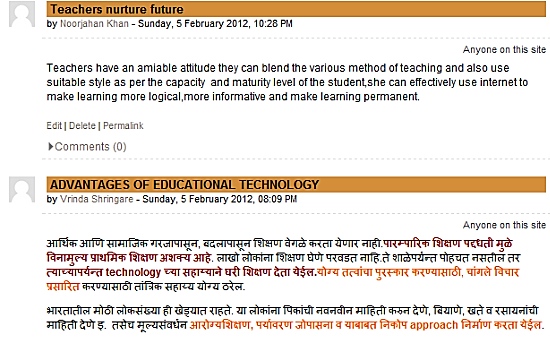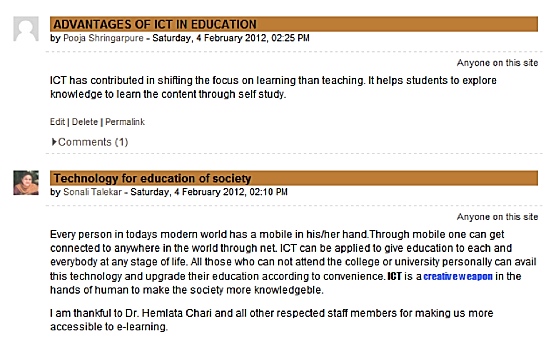Open and Distance Learning in India: Maintaining Balance with Technology
India is a country of diversity. The present scenario of higher education is overwhelming. As all are aware India is the Second populous country of the world. There is a growing imbalance between the intake of students and those seeking admissions. Indian Education system follows a 10+2+3 pattern
Today there are around 300 universities and equivalent institutions together with 13,000 colleges with 8.8 million students. Though such an expansion has democratized higher education, (40 per cent of students are from low socio-economic strata together with 35 per cent being women).
Technology has reached almost all provinces in India, it’s true that every house even in remote places there is at least one mobile in every home. This has led to a window to the world of techno savvy inquisitives maybe using computers or Mobiles.
In rural areas, Farmers are using mobiles in dealing with their produce on a day to day basis. There are Open Universities that offer programs through distance mode.
Most of the universities in India are adapting to technology based teaching.
.
As mentioned in the slides, there is a imbalance in access and training of technology based teaching. Faculty recalcitrance is a major concern, most of the faculties prefer the conventional mode of teaching. It is interesting during my interaction with some faculties and Heads at the Departments from University of Mumbai-their concern was not using technology in teaching or offering online learning programs. Their main concern was regarding the teaching hours as they are comfortable in stating their teaching loads based on number of hours per week.
Coming back to students at IDOL, for M.A –Education part II, it is surprising that in an optional paper of ICT, approximately 180 students out of 540 opted for online program. Most of them did not have computer at home nor email id, today all have accessed the university website and contributed effectively by participating in Blogs, screenshots of some are provided in this paper.


Student’s who could not type and use keyboards are sending assignments online. A remarkable achievement by IDOL University of Mumbai.

Hi Hemlata. Great to read your piece! Could you perhaps share with us techniques you use to make faculty more enthusiastic about integrating new technology into their teaching. Have you been able to convince some to begin modestly to allow them to discover the time/ efficiency/ quality benefits? Perhaps you could also say a little about how distance education providers are assessed on the quality of their provision, and the interface between institutions and regulatory authorities.
Sure Nick we use multi media techniques. In india due to diverse student population there is definitely a demand for Print materials. At IDOL, We design and develop course materials in all programs we offer. In addition we use technology based teaching. using technologies like Camstudio/ spoken tutorial basically this is an Audio set up for students to listen, We either link our Power points to You tube if you log in Youtube and type idolmumbai university you can see them. Besides we copy them in CD/VCD. Next in pipeline is m learning.
Regarding regulatory authorities at IDOL we go through two regulatory bodies , the reason we are dual mode university basically our authority body is DEC-Distance Education Council . They provide us certain benchmarks to be achieved. As mentioned earlier our main issue is Time , since these faculties teach in regular colleges it is hard for them to provide time. Quality is an important factor- as far as bogging or materials online we ensure quality another area of concern for us is the technological support. this is due to large number of students
A simple example our M.Com students registered through distance is 15,000 how to assess? examiners are scarce as they have to manage their regular college work and if time permits assess– A big issue any suggestions on how to handle this crisis welcome.
visit our website http://www.mu.ac.in/idol
Hello Hemlata – it is good to hear that you have been having some success with online learning in your institution. I am part of a European project seeking to do an inventory of online schools and colleges (not university-level) and I wonder if there are also instances of these in India? Any hints would be much appreciated 🙂
Sure Maggie I shall be more than happy to offer support in this project. there are community colleges and open university courses do send details at drhemchari@gmail.com or hemlata@idol.mu.ac.in
A great write up. E-learning is the next step in education that bring about the much needed changes in Indian education. As long as technology remains the "means" in education to impart learning, we are heading the right way
thanks Manpreet
You may find this paper relevant to the discussion:Distance Education: A Pathway to the FutureDevelopment is a process of structural change in the economic, political, social and cultural domains. Development starts with people, their education and their capabilities because people are the primary and ultimate focus of all development. The broader goal of development is to bring the entire population into the mainstream of the national development process, both as contributors and beneficiaries. In the final analysis, development is the development of an individual, each according to his or her potential, and in this sense education is a crucial aspect of development….Professor Motilal SharmaRetd. Princiapal Education Specialist, ADB
I'M very happy to comment because I learn ICT is important in teacher-student life and ICT has contributed
in shifting the focus on learning than teaching . it helps student to explore knowledge to learn the content through self study.
i,m very happy to comment because ICT is very important in today life because ict has contributed in shifting the focus on learning than teaching .it helps to explore knowledge to learn the content through self study.